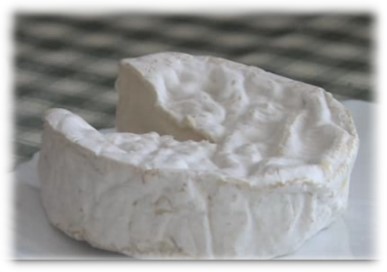
An interesting little video on the Guardian Online site about the struggle to protect the genuine Camembert cheese from Normandy. I had not realised that the name Camembert is not protected in the same way as Champagne wine or Pont l’Eveque cheese, so almost anyone can make a soft cows milk cheese and call it Camembert. The only product which is protected is the raw-milk (lait cru) Camembert de Normandie AOC, which is strictly controlled and limited to only 5 producers in Normandy.
I must admit I have just checked the Camembert I had for lunch yesterday (very nice and in that perfect state of gloopiness before the ammonia kicks in) – but it is not an AOC, despite being made by a reputable (but big) French producer in Normandy!
Camembert is the king of Normandy cheeses, made from cows milk to produce a soft round cheese with a soft white rind, but there appears to be come internal squabbling between small local producers and the big dairy companies – battles that are being fought over the methods of making traditional raw milk Camembert
The raw milk version has a richer flavour and better texture than the pasteurised version, which is the most common. However, because the milk in the traditional version is unpasteurised, there is a small risk of food poisoning, particularly for the young, old and infirm. Fortunately to date, the raw milk version has not been banned in the interests of health and safety, but this spat between producers cannot help.
* How do you know when your Camembert is ready to eat?
- The traditional saying in Normandy is that “a ripe Camembert squeezes like a woman’s breast”. But there is a more scientific test.
- Cut into the cheese and look at the width of the crusty layer in the centre. If it is “as thick as a knife blade”, the Camembert is perfect. If it is thicker, the cheese is not quite at its best. If there is no crusty layer, it is a little too ripe.
- A Camembert should always be stored upside down, to preserve the beauty of the top of the cheese when served. Ideally, a Camembert should never be put in the fridge. If you do, take it out at least an hour before eating.
- Gourmets say that the best time for eating Camembert is during the late spring and early summer. This means that you will then be eating, via the cow and the factory, the rich flush of Norman spring grass.
For more info on Camembert, see the website of producer Fromagerie Gillot

Just 3 miles from Camembert at Le Renouard you could stay at the B&B Le Vieux Chateau – a traditional castle within with B&B accommodation,a garden, terrace and shared lounge. Parts of the castle date back 1000 years!
Discover more from FrenchDuck.com
Subscribe to get the latest posts sent to your email.